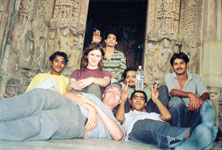Trip allows peace search

Mac Kenney, junior French and sociology major, bottom left, Alice Ensor, junior communication and German major, second from left, sit with a group of young men in an abandoned temple.
The late Kenneth McCaleb and his wife Margaret established the McCaleb Initiative for Peace in 1998. Both the McCalebs graduated from Joplin Junior College, the institution that would become Missouri Southern, and traveled extensively around the world. Kenneth served as a navigator in World War II and was shot down over Germany, where he spent the next 19 months in a prisoner of war camp. Kenneth returned to the United States with a hope to prevent the havoc war had played on his life from happening to new generations. Thus, he established the Peace Initiative to promote research on the broad topic of peace. Each year the Initiative awards teacher-student teams up to $5,000 for summer projects, “in search of peace.”
In the spring of 2003, I was one of four McCaleb scholars. My mission revolved around the history of religion in India and its contemporary place in Indian society. How have so many religious traditions coexisted literally side-by-side? How do they understand each other? I was particularly intrigued by the ways in which Muslim/Hindu coexistence had taken shape over the Indian sub-continent’s history. What are the histories of these faiths in India? Some of these questions brought me to India; others came to me while I was there.
Before departing I had taken classes and read books about Indian culture, history and religion, none of which prepared me for the stunning experience of India. Something funny happens when you learn – you discover more questions than answers. This can sometimes be frustrating, but also exhilarating. This experience both frustrated and exhilarated me this summer as I learned many things about India.
My search for peace had three phases: a tour of Northern India, a study program at the University of Hyderabad and a tour of Southern India.
I first arrived in New Delhi with Dr. Karl Schmidt, director of international programs at South Dakota State University, and fellow student Alice Ensor. Over the course of 14 days the three of us traveled across northern India, moving from village to village on a quest to visit unique historical sites. Soon, we met up with four other Southern students with whom I would spend the next seven weeks.
During the Southern-in-India study program, we explored Delhi, visited the magnificent Taj Mahal in Agra, spent six weeks at the University of Hyderabad and saw ancient Buddhist, Jain and Hindu caves carved deep into India’s Western Ghats (a mountain range on the west coast).
During this time we were joined by Southern professors Dr. Bill Kumbier, faculty adviser to the Southern students, and later by Dr. Ree Wells, faculty adviser for my McCaleb Peace Initiative. Throughout, I tried to understand the roots of the long and largely peaceful coexistence between the diverse peoples of India.
Near the end of July, Wells, Kumbier and myself traveled to the beautiful state of Kerala in Southwest India. There we saw firsthand the foothold of Christianity in India and the oldest Jewish settlement in Cochin. The diverse and bustling city of Kolkata in Northwest India concluded my formal study of Indian culture. My visit to India ended on the scenic beaches of Goa.
These articles are meant to lead the reader through my experiences and understanding of India, religion and the roots of coexistence. The very number of different religious beliefs and ways of life that can be found in a single country, state or village is striking and testifies to the possibilities of religious coexistence.
Your donation will support the student journalists of Missouri Southern State University. Your contribution will allow us to purchase equipment and cover our annual website hosting costs.



























